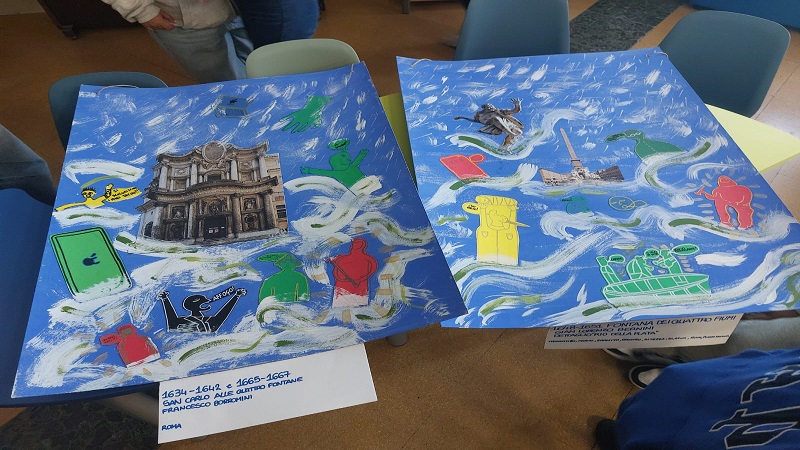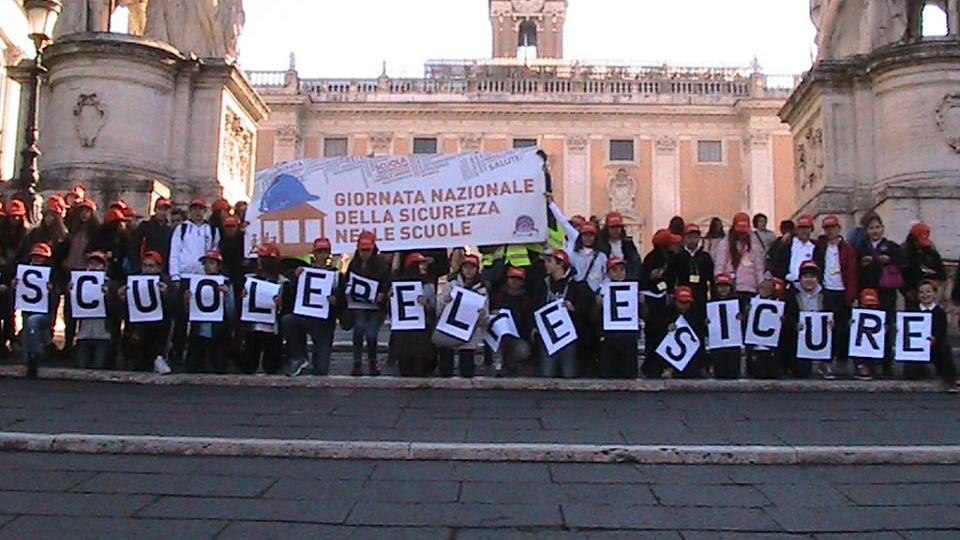Safer schools? It does not seems to, but we ask it to the Ministry. Without Registry is likely inappropriate actions and funds wasted. And 390 million euro in the last school year for families. Presented XI Report on safety, quality and accessibility to school
In a school out of seven structural lesions, detachment of plaster in one out of five and, during the last school year, at least 29 cases of tragedies touched due to collapse of varying significance in schools. Improve data on the possession of the certificates, instead worsens the state of maintenance of schools in 39% of cases it is inappropriate, as well as the quality of life within school settings, more interested in the past, perhaps because last year particularly rainy, mold, leaks and signs of moisture affecting classroom on five. And a third of schools have suffered acts of vandalism.
Most schools seem free of architectural barriers, but in reality the accessibility often stops at the only entrance, we find beyond in one cases out of four inaccessible classrooms to students in wheelchairs and without furniture and teaching equipment intended for them.
Still in the last year, from families arrived around 390 million euro in the form of voluntary contribution or donation of materials and goods, without which our school could not get along.
|
schools |
Students / Fam. 70% |
donors |
Average amount |
TOTAL € |
|
CHILDHOOD |
1.030.364 |
721.255 |
50€ |
36.062.750 |
|
PRIMARY |
2.596.915 |
1.817.841 |
50€ |
90.892.050 |
|
SECONDARY 1st grade |
1.671.375 |
1.169.963 |
70€ |
81.897.410 |
|
SECONDARY 2nd degree |
2.580.007 |
1.806.004 |
100€ |
180.600.400 |
|
Source: Cittadinanzattiva 2013 |
389.452.610€ |
|||
This is the condition of the Italian schools, photographed from the XI Report on safety, quality and comfort of school buildings, presented on 18 September in Rome and made by Cittadinanzattiva in collaboration with the Italian Union Fight against Muscular Dystrophy (UILDM). The survey involved 165 schools in 18 regions, all with the exception of Valle D'Aosta and Liguria, and was conducted from 155 through 446 citizens monitors indicators.
"While we appreciate the great effort made by the current government with the allocation of funds (150 million immediately, 300 in the next three years), it is little compared to the real needs. Just think of the cost of a school building of medium size, antiseismic, energy costs under € 5 million, "says Adriana Gonzo, national coordinator of the school Cittadinanzattiva (School of active citizenship Cittadinanzattiva). "It’s enough now with the Registry school everlasting unfinished and ghost, which is instead the institutions essential for a serious and reliable programming on schools to fix and which priorities to invest the funds of the Decree of Making, and it is essential for families to know in which schools go every day our children. For this we used the procedure for access to civic acts against the Ministry of Education that, within 30 days, as provided for by the Decree 33/2013 on transparency will answer us on the Registry. To protect especially the younger and students with disabilities, affected more than others by the poor condition of school buildings. "
Some certification in most, but worsens the maintenance and the condition of the classrooms
In one school out of seven there are obvious structural lesions, present in large part on the outside of the building, 20% of the classrooms presents detachment of plaster: mold, moisture and infiltration were detected in nearly one-third of the bathrooms (31%) and in a classroom and gym out of four.
39% of schools presents a state of maintenance completely inadequate (last year it was 21%), as revealed by those in charge of the service of protection and prevention interviewed by Cittadinanzattiva. 84% of cases have required maintenance to the institution concerned, but the latter, in 21% of situations, intervened very late. The structural interventions, which require more money and time, were required in 34% of schools, but only one in four cases the entity owner has intervened promptly and in 14% of cases, intervention is never arrived.
44% of schools have the certificate of occupancy static, 38% to health and hygiene practicability and 37% that of fire prevention. Last year, only a quarter of the schools was in compliance with all certifications.
67% of school buildings monitored is situated in areas of high earthquake risk, 12% in landslide risk areas.
the bad state of maintenance means that in one classroom out of four (25%) there are signs of decay, such as moisture, mold, water leaks as well as the detachment of plaster visible in a classroom of 5 (20%). Architectural barriers (13%) and uneven floors (12%), obstruct the lives of students with disabilities present in increasing numbers in our schools. And sit in the classroom is harmful to health: temperatures and aerating are not adequate in most of the classrooms, given that 51% of them are without window blinds or shutters and 28% has broken windows. And yet 10% of chairs and of desks are broken and in over a third of cases (39%) the furnishings are not up to standard, suitable for example the height of the pupils.
FOCUS CLASSROOMS
|
|
13% |
|
Detachment of plaster |
20% |
|
Other signs of decay |
25% |
|
Unsound Windows |
28% |
|
Opening antipanic Doors |
29% |
|
Any divergence of floors |
12% |
|
Electrical and fire prevention standards appropriate |
89% |
|
Sockets and switches broken |
3% |
|
Flying leads |
8% |
|
Without roller blinds and shutters |
51% |
|
Desks damaged |
10% |
|
Chairs damaged |
9% |
Report XI Safety at school, 2013 - Cittadinanzattiva
And we move on to chapter overcrowding. A class in five of our sample has more than 25 students, so it is not appropriate to the fire regulations. And while referring to repeatedly objected art.64 of law 133/2008, which raised the limit class sizes, we found no less than 47 classes outlaw.
Accessibility and services for students with disabilities
We are to quota 207,244 students with disabilities placed in our schools.
64% of schools being monitored has parking spaces for people with disabilities in the backyard or in the parking lot.
Steps at the entrance of the 27% of schools, elevator absent in 35% of the buildings and not working in 11% of those who have it; architectural barriers in 19% of laboratories, 18% of the gyms, in 15% of the courtyards , 13% of the classrooms. In 23% of schools there are no disabled toilets, and 15% of them are accessible by wheelchair.
26% of the schools, in most of the classrooms, does not have enough space for the presence of a wheelchair; 44% of the classrooms do not have desks suitable or adaptable for a person in a wheelchair, in 57% of cases, there are classroom teaching equipment or technology to facilitate participation in the classes of students with disabilities. There are no tables or seats suitable for disabled people in wheelchairs in 28% of laboratories, 18% of libraries and 17% of the canteens.
In a school out of 4, it would be a problem to manage the evacuation of the building for students with physical disabilities in case of emergency, because in 24% there are no feasible and safe routes that do not involve the use of the lift or stair lift. In addition, in 27% of monitored buildings, floor plans evacuation routes are not visible to people in wheelchairs.
The safety of children
97 of the 165 school buildings monitored host-schools and primary schools, so children between 3 and 11 years.
A school out of four have interconnecting doors directly out of state roads, provincial or high traffic, but in all cases there is a traffic light or supervision by auxiliary staff to traffic. The entrance is not constantly monitored in 16% of cases and 64% were found the gates open during the lessons. 17% of schools do not have anti-slip on the steps.
40% of the bathrooms is devoid of toilet paper, 43% have no towel, no soap, 38% and 13% are unattended equipment and cleaning products.
The classrooms have in 27% of cases damaged chairs, desks broken in 23%, 42% in cabinets and bookcases not anchored to walls, furniture or radiators in 44% with sharp edges, in 55% non-compliant windows. Not all have places reserved for the table: they are equipped with 62 of the 97 schools and in 7 of these you eat in the classroom.
There are green areas in 85% of preschools and primary schools monitored, but 32% are not adequately treated. Only in 43% of these areas are set to play area equipped with the specifications.
The welfare and hygiene in school: from the gyms to the courtyards to the baths
28% of schools do not have a gym inside the building. Where present, the gyms are chipping plaster (19% of cases), mold and leaks (24%), architectural barriers (18%), sources of danger (23%), 8% of cases do not have any kind of equipment and almost one in two (44%) has no first aid kit. The gyms are then dusted the environment of the school. The courtyards, which are present in most of the schools examined (in 149 of the 165 schools) in half of the cases (47%) are used for sports activities. 83% of the courtyards there are green areas, but are well-maintained only in 65% and treatment areas equipped sports game in 36%.
To the baths instead the dubious distinction of dirtier environment: no soap in 41% of cases, in 53% of towel, toilet paper in 50%. Elements particularly serious seen that it is increasingly difficult to rely on the help of school staff in assisting the children to the bathroom.
The signs indicating the smoking ban are present in 65% of the corridors of schools, are completely absent in 22% and in the remaining 13% appear only in certain parts of the school building.
In terms of nutritional wellness, in 65% of schools there are vending machines for drinks and 32% of those snacks. Only in 6 schools were found distributors of natural products or fresh, like yogurt and fruit.
More than one school in three (36%) provides, in the case of students with chronic diseases, the administration of medication during school hours, which, despite the recommendations issued by the Ministry of Health and Education in 2005, is managed differently from school to school. In our sample, 87% of cases, the administration is carried out by school staff, 20% by family members, of course, sometimes the figures are both internal and external.











